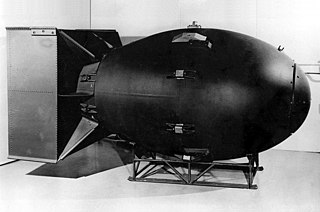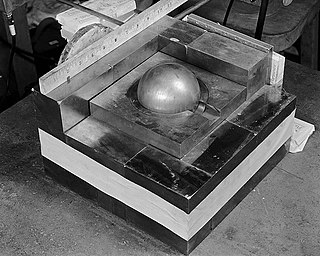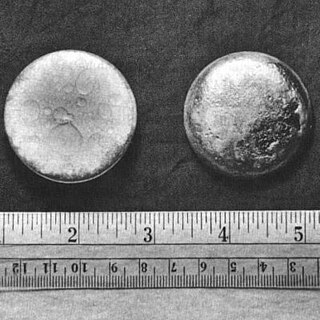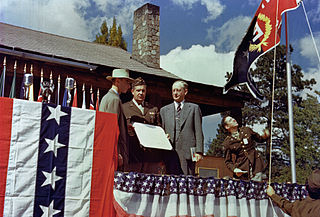Related Research Articles

"Fat Man" was the codename for the type of nuclear weapon the United States detonated over the Japanese city of Nagasaki on 9 August 1945. It was the second of the only two nuclear weapons ever used in warfare, the first being Little Boy, and its detonation marked the third nuclear explosion in history. It was built by scientists and engineers at Los Alamos Laboratory using plutonium from the Hanford Site, and was dropped from the Boeing B-29 Superfortress Bockscar piloted by Major Charles Sweeney.
In nuclear engineering, fissile material is material that can undergo nuclear fission when struck by a neutron of low energy. A self-sustaining thermal chain reaction can only be achieved with fissile material. The predominant neutron energy in a system may be typified by either slow neutrons or fast neutrons. Fissile material can be used to fuel thermal-neutron reactors, fast-neutron reactors and nuclear explosives.

Nuclear weapon designs are physical, chemical, and engineering arrangements that cause the physics package of a nuclear weapon to detonate. There are three existing basic design types:

In nuclear engineering, a critical mass is the smallest amount of fissile material needed for a sustained nuclear chain reaction. The critical mass of a fissionable material depends upon its nuclear properties, density, shape, enrichment, purity, temperature, and surroundings. The concept is important in nuclear weapon design.

A neutron source is any device that emits neutrons, irrespective of the mechanism used to produce the neutrons. Neutron sources are used in physics, engineering, medicine, nuclear weapons, petroleum exploration, biology, chemistry, and nuclear power.

Operation Sandstone was a series of nuclear weapon tests in 1948. It was the third series of American tests, following Trinity in 1945 and Crossroads in 1946, and preceding Ranger. Like the Crossroads tests, the Sandstone tests were carried out at the Pacific Proving Grounds, although at Enewetak Atoll rather than Bikini Atoll. They differed from Crossroads in that they were conducted by the Atomic Energy Commission, with the armed forces having only a supporting role. The purpose of the Sandstone tests was also different: they were primarily tests of new bomb designs rather than of the effects of nuclear weapons. Three tests were carried out in April and May 1948 by Joint Task Force 7, with a work force of 10,366 personnel, of whom 9,890 were military.

Castle Bravo was the first in a series of high-yield thermonuclear weapon design tests conducted by the United States at Bikini Atoll, Marshall Islands, as part of Operation Castle. Detonated on March 1, 1954, the device remains the most powerful nuclear device ever detonated by the United States and the first lithium deuteride-fueled thermonuclear weapon tested using the Teller-Ulam design. Castle Bravo's yield was 15 megatonnes of TNT (63 PJ), 2.5 times the predicted 6 megatonnes of TNT (25 PJ), due to unforeseen additional reactions involving lithium-7, which led to radioactive contamination in the surrounding area.

A boosted fission weapon usually refers to a type of nuclear bomb that uses a small amount of fusion fuel to increase the rate, and thus yield, of a fission reaction. The neutrons released by the fusion reactions add to the neutrons released due to fission, allowing for more neutron-induced fission reactions to take place. The rate of fission is thereby greatly increased such that much more of the fissile material is able to undergo fission before the core explosively disassembles. The fusion process itself adds only a small amount of energy to the process, perhaps 1%.
Uranium-233 is a fissile isotope of uranium that is bred from thorium-232 as part of the thorium fuel cycle. Uranium-233 was investigated for use in nuclear weapons and as a reactor fuel. It has been used successfully in experimental nuclear reactors and has been proposed for much wider use as a nuclear fuel. It has a half-life of 160,000 years.

Gun-type fission weapons are fission-based nuclear weapons whose design assembles their fissile material into a supercritical mass by the use of the "gun" method: shooting one piece of sub-critical material into another. Although this is sometimes pictured as two sub-critical hemispheres driven together to make a supercritical sphere, typically a hollow projectile is shot onto a spike, which fills the hole in its center. Its name is a reference to the fact that it is shooting the material through an artillery barrel as if it were a projectile.

Weapons-grade nuclear material is any fissionable nuclear material that is pure enough to make a nuclear weapon or has properties that make it particularly suitable for nuclear weapons use. Plutonium and uranium in grades normally used in nuclear weapons are the most common examples.

The Mark 18 nuclear bomb, also known as the SOB or Super Oralloy Bomb, was an American nuclear bomb design which was the highest yield fission bomb produced by the US. The Mark 18 had a design yield of 500 kilotons. Nuclear weapon designer Ted Taylor was the lead designer for the Mark 18.
Plutonium-240 is an isotope of plutonium formed when plutonium-239 captures a neutron. The detection of its spontaneous fission led to its discovery in 1944 at Los Alamos and had important consequences for the Manhattan Project.
The term insertion time is used to describe the length of time which is required to rearrange a subcritical mass of fissile material into a prompt critical mass. This is one of the three main requirements in a nuclear weapon design to create a working fission atomic bomb. The need for a short insertion time with plutonium-239 is the reason the implosion method was chosen for the first plutonium bomb, while with uranium-235 it is possible to use a gun design.

Plutonium is a chemical element; it has symbol Pu and atomic number 94. It is an actinide metal of silvery-gray appearance that tarnishes when exposed to air, and forms a dull coating when oxidized. The element normally exhibits six allotropes and four oxidation states. It reacts with carbon, halogens, nitrogen, silicon, and hydrogen. When exposed to moist air, it forms oxides and hydrides that can expand the sample up to 70% in volume, which in turn flake off as a powder that is pyrophoric. It is radioactive and can accumulate in bones, which makes the handling of plutonium dangerous.

The Dayton Project was a research and development project to produce polonium during World War II, as part of the larger Manhattan Project to build the first atomic bombs. Work took place at several sites in and around Dayton, Ohio. Those working on the project were ultimately responsible for creating the polonium-based modulated neutron initiators which were used to begin the chain reactions in the atomic bombs.

The uranium hydride bomb was a variant design of the atomic bomb first suggested by Robert Oppenheimer in 1939 and advocated and tested by Edward Teller. It used deuterium, an isotope of hydrogen, as a neutron moderator in a uranium-deuterium ceramic compact. Unlike all other fission-based weapon types, the concept relies on a chain reaction of slow nuclear fission. Bomb efficiency was adversely affected by the cooling of neutrons since the latter delays the reaction, as delineated by Rob Serber in his 1992 extension of the original Los Alamos Primer.

In nuclear weapon design, the pit is the core of an implosion nuclear weapon, consisting of fissile material and any neutron reflector or tamper bonded to it. Some weapons tested during the 1950s used pits made with uranium-235 alone, or as a composite with plutonium. All-plutonium pits are the smallest in diameter and have been the standard since the early 1960s. The pit is named after the hard core found in stonefruit such as peaches and apricots.

The Los Alamos Laboratory, also known as Project Y, was a secret laboratory established by the Manhattan Project and operated by the University of California during World War II. Its mission was to design and build the first atomic bombs. Robert Oppenheimer was its first director, serving from 1943 to December 1945, when he was succeeded by Norris Bradbury. In order to enable scientists to freely discuss their work while preserving security, the laboratory was located on the Pajarito Plateau in Northern New Mexico. The wartime laboratory occupied buildings that had once been part of the Los Alamos Ranch School.
A tamper is an optional layer of dense material surrounding the fissile material. It is used in nuclear weapon design to reduce the critical mass of a nuclear weapon and to delay the expansion of the reacting material through its inertia. Due to its inertia it delays the thermal expansion of the fissioning fuel mass, keeping it supercritical longer. Often the same layer serves both as tamper and as neutron reflector. The weapon disintegrates as the reaction proceeds and this stops the reaction, so the use of a tamper makes for a longer-lasting, more energetic and more efficient explosion. The yield can be further enhanced using a fissionable tamper.
References
- ↑ Nuclear Weapons FAQ, Section 4.1, Version 2.04: 20 February 1999
- ↑ The Design of Gadget, Fat Man, and "Joe 1" (RDS-1) Archived 2010-02-10 at the Wayback Machine . Cartage.org.lb. Retrieved on 2010-02-08.
- ↑ On the Origins of the Soviet Atomic Project. Nuclearweaponarchive.org (1998-04-15). Retrieved on 2010-02-08.
- ↑ Nuclear Weapons FAQ, Section 8.0, Version 2.18: 3 July 2007
- ↑ 4.1 Elements of Fission Weapon Design. Nuclearweaponarchive.org (1953-05-19). Retrieved on 2010-02-08.
- ↑ Abrahamson|The Sandia Pioneers. Unc.edu. Retrieved on 2010-02-08.
- ↑ Injecting Polonium into Humans, Federation of American Scientists, December 12th, 2006 by Steven Aftergood
- ↑ Ferenc Morton Szasz (1992). British scientists and the Manhattan Project: the Los Alamos years. Palgrave Macmillan. pp. 24–. ISBN 978-0-312-06167-8 . Retrieved 22 April 2011.
- ↑ "The Manhattan Project and predecessor organizations". Array of Contemporary American Physicists. American Institute of Physics. Archived from the original on 2012-10-17. Retrieved 2013-03-11.
- ↑ Carey Sublette, Section 8.0 The First Nuclear Weapons, The Nuclear Weapon Archive : A Guide to Nuclear Weapons (July 3, 2007).
- ↑ Carey Sublette. (6 August 2001). Gallery of U.S. Nuclear Tests
- ↑ India's Nuclear Weapons Program – Smiling Buddha: 1974. Nuclearweaponarchive.org. Retrieved 2010-02-08.
- ↑ Archived June 4, 2011, at the Wayback Machine
- ↑ Uranium Deuteride Initiators. ArmsControlWonk (2009-12-14). Retrieved on 2010-02-08.
- ↑ Polonium. Globalsecurity.org (2005-04-27). Retrieved on 2010-02-08.
- ↑ The Making of the Atomic Bomb, Richard Rhodes, 1986, Simon & Schuster, ISBN 0-684-81378-5 p. 580
- ↑ Note by the secretary, Subject: part III – Weapons Progress Report to the Joint Committee, June – November 1953 . Retrieved on 2010-02-08.
- ↑ United States Nuclear Weapons. Globalsecurity.org. Retrieved on 2010-02-08.